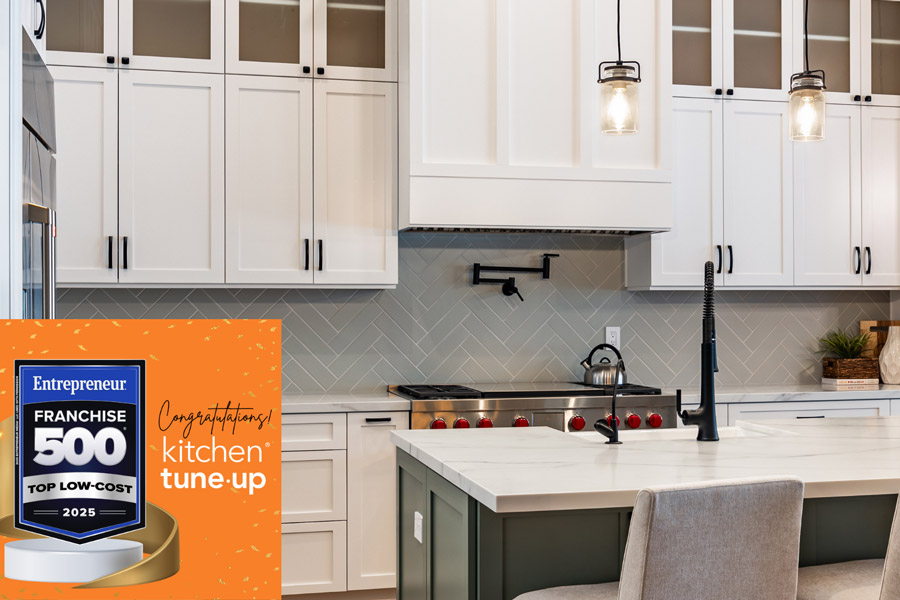How to Start a Kitchen Cabinet Business: 7 First Steps
Despite everything that happened in 2020, with the global pandemic and the economic crisis that has ensued, it does not seem like Americans lost the entrepreneurial spirit. As a matter of fact, people all over the world have begun looking for ways to become business owners in an attempt to create their own fate instead of relying on employers that, as 2020 proved, can have no problem laying people off when the times get rough.
The home remodeling industry is a great one to get into nowadays. Due to the impact of the COVID-19 pandemic, people have decided to move out of their cramped-up, expensive big city apartments into cheaper, more spacious countryside or suburban houses. Experts claim that because of the rise of home offices and the freedom it has granted to many employees, this trend is only going to continue in the foreseeable future.
Whenever a family moves homes, a kitchen remodel is often one of the first things on their minds. Design trends may change with time, but regardless of what’s “in” at any given moment, people are always going to need furniture, such as kitchen cabinets.
Are you looking for ideas for a new business, and want your company to stay immune to passing fashion fads, actually helping people improve their lives? A kitchen cabinet business might be just what you’re after!
Starting a Cabinet Shop
If you have never been a cabinet business owner before, the entire process of opening up a company may seem a little tricky to you. Or quite the opposite—you might be thinking that it’s straightforward and simple.
Just like with many things in life, in this case, the truth lies somewhere in the middle, too. The difficulty of starting a new cabinet shop business shouldn’t deter you from trying it out if you are determined to do so, but you also should not underestimate it. Below, you’re going to find some useful tips and the basic steps that will surely help you get over the initial hurdles of the process.
Cabinet Shop Business Plan
Whether you’re starting a cabinet business or any other sort of a company, you’re going to need to have a thorough, well-thought-out plan that will analyze each and every aspect of your business, from the name, an estimate of the initial costs, the location as well as how you’re going to go about making your products. Will you create the cabinet in-house, or are you going to enlist the services of a third-party factory to handle the manufacturing? Both ideas have their pros and cons. Regardless of which one you end up going for, the reasoning behind this decision should be included in your business plan.
It’s important to have a comprehensive plan for a variety of reasons. First of all, if you’re operating on a tight budget and hope to attract investors or potential partners to your idea, they’re not going to want to join you if you are clueless about how you want to push the project forward. Like you, they’re in it for the profit. This business is not their brainchild, though. You can’t expect them to blindly follow you into it, especially if their money is on the line.
Even if you’ve already secured funding, either from your own savings or because you’ve already established a partnership with someone, having a solid business plan can go a long way in terms of the stability and security of your firm.
Competition
A crucial part of your preparations for opening up a cabinet business should be an analysis of your competitors, especially those that have opened up their cabinet stores in your location. Ideally, you should be on the lookout for a spot where this sort of service is in high demand without many businesses looking to meet it.
However, if, for whatever reason, that proves to be impossible, you need to perform a thorough investigation into everything they have on offer and try to see what they’re missing. Then, you should do everything you can to fill that gap. Not only will it put your brand out there much faster, but it could also lead many loyal customers to abandon your competitors now that there are more competent cabinet makers in town.
These little additions could be anything, from “insurance” packages for the newly shipped cabinets, to free delivery and setup. Whatever you do, you need to make sure that it does not take anything away from your product and does not increase your business expenses too much.
Customers
Market research is a fundamental aspect of running any sort of business, whether it is selling kitchen cabinets or anything else. Every successful enterprise should revolve around people, and that is the main thing you need to keep in mind when devising your marketing strategy. If you’re planning to establish a strong, competitive online presence, you need to ensure the perfect user experience when navigating your website, with easy access to all of the necessities like customer service or the online store.
Building a good relationship with customers is about much more than just a functioning website and a customer service system. In order to truly strike gold with the consumers in your area, you need to truly show them that you care. Apply customer-friendly strategies, such as providing free shipping for orders that exceed a certain price or seasonal promotions that are going to help you drive people away from the competition. All of these seemingly little things are going to go a long way in helping you establish your brand’s reputation as a solid and reliable kitchen cabinet provider.
Resources
No business plan can be complete without a comprehensive outline of expenditures and what is needed to get everything up and running. Having “resources’’ doesn’t only mean specific amounts of money needed for your business to start generating profit. It also entails the buildings you’re either going to need to lease or buy as your base of operations and space where you’re going to produce your cabinet units. Your essential resources also include your employees and the materials you’ll use to create the cabinets. Things such as insurance, employee wages, and opportunity costs should also be included if you want to go through these difficult beginning stages of running a business as smoothly as possible.
Costs of Running a Cabinet Business
Now that we’ve established that compiling a thorough analysis of your costs is one of the crucial parts of planning a successful enterprise, we should delve deeper into what all of these expenditures entail and how much (roughly) you would have to spend on opening a kitchen cabinets company from scratch.
For most of the businesses in this industry, the start-up costs land somewhere between $2,000 and $10,000 on average. Now, these estimates are quite widespread. How then can you make sure that your actual expenses fall closer to the lowest price?
Unfortunately, it is not as simple as saving up on the quality of the materials and woodworking for your cabinets. The costs of leasing spaces for business purposes, administrative fees, and taxes differ from state to state. A Wyoming entrepreneur will probably be able to successfully open up a cabinet firm at a fraction of what it would cost for their Californian counterparts. Wyoming is simply a more attractive business environment for up and coming entrepreneurs. We recommend you take a look at this ranking of the best and worst states to start a business in if you have the freedom to choose where you’re going to start your cabinet empire.
Aside from taxes and administrative fees, you should also not look past the material cost of things such as tools, delivery vehicles, and your workshop. As you’re going to be starting completely from scratch, you’re also going to have to set aside a substantial amount of cash for advertising. There is a way to avoid that last part, though, but you’ll read more about that later on in this article.
Potential Profits: How Much Can You Make in the Cabinet Business
The cost of operating a cabinet business may get relatively high in some areas, but it can prove to be more than worth it if you make enough money off of it. The profit margin for cabinets usually falls somewhere between 25% and 50%. This is heavily dependent on how much you actually put into making each cabinet. Generally, the less you invest in each unit, the higher your potential profit margin. Keep in mind that this is a thin line. Not every business laminates their cabinets or uses high-quality wood to produce them, but this can directly impact their brand’s reputation and relationship with customers.
If you use subpar materials to create your cabinets, sooner or later, you’re going to have to drive your prices down significantly if you hope to stay in business. This is not to say that you’re going to need to pay a maximum price for each piece of wood and splash out for the most expensive option during each step of the production process. Instead, you should weigh every single step and question every single expenditure to see where you can save a few bucks without lowering the price, and where you can afford to spend on top-shelf materials.
When it comes to the matter of pricing, every kitchen cabinet is priced “per foot”. Here is a brief outline of the average cabinet prices in the US - from this you can get an indication of what you should then be charging your customers:
• Stock cabinets: $60-$200/foot,
• Semi-custom cabinets: $100-$650/foot,
• Custom cabinets: $500-$1200/foot.
Consider Investing in a Franchise
Opening a business on your own and having to take care of matters such as branding, advertising, and the start-up procedure, in general, can be a real pain. Especially if you don’t have a lot of managerial experience or don’t know much about the world of kitchen cabinets and remodels.
Thankfully, there is a simple way for aspiring entrepreneurs to reduce (or completely eradicate) the advertising cost, all the while getting a professional introduction into the kitchen industry. Buying into a franchise such as Kitchen Tune-Up is a hassle-free way to start running your own cabinet shop. If you’ve got the right property to operate out of, and enough money for the initial investment, you’re going to be able to start working and making profits in no time!
The benefits of working within a franchise include having a ready advertising and marketing strategy (one that you don’t have to spend extra money on), receiving comprehensive training regarding the cabinet-making process and the franchise standards (no need for previous experience in the field). Finally, you’ll have a ready brand-name and will be able to reach out to experienced, qualified cabinet experts for help.
The Bottom Line
Starting a business is never easy. Whether you’re looking to get into the cabinet industry, a bathroom or kitchen renovation niche, or invest your hard-earned money into any other kind of home improvement enterprise, you need to carefully plan your course of action and weigh out the pros and cons of each decision you make along the way. If you don’t have previous experience in the industry but still want to become a part of it, you might want to consider buying a well-known, established franchise such as Kitchen Tune-Up. It will save you the time and money you’d otherwise have to spend on training and marketing campaigns, all the while letting you accrue roughly the same amount of profit as you would as an independent entity. See our Benefits and Initial Investment pages for more on what you can expect to gain from joining us at Kitchen Tune-Up.

